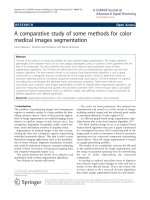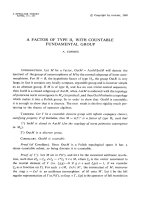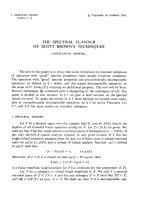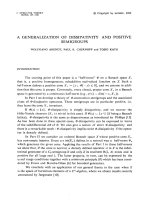Báo cáo toán học: "A q-analogue of some binomial coefficient identities of Y. Sun" ppt
Bạn đang xem bản rút gọn của tài liệu. Xem và tải ngay bản đầy đủ của tài liệu tại đây (88.89 KB, 6 trang )
A q-analogue of some binomial coefficient
identities of Y. Sun
Victor J. W. Guo
1
and Dan-Mei Yang
2
Department of Mathematics, East China Normal University
Shanghai 200062, People’s Republic of China
1
,
2
plain
Submitted: Dec 1, 2010; Accepted: Mar 24, 2011; Published: Mar 31, 2011
Mathematics Subject Classifications: 05A10, 05A17
Abstract
We give a q-analogue of some binomial coefficient identities of Y. Sun [Electron.
J. Combin. 17 (2010), #N20] as follows:
⌊n/2⌋
k=0
m + k
k
q
2
m + 1
n − 2k
q
q
(
n−2k
2
)
=
m + n
n
q
,
⌊n/4⌋
k=0
m + k
k
q
4
m + 1
n − 4k
q
q
(
n−4k
2
)
=
⌊n/2⌋
k=0
(−1)
k
m + k
k
q
2
m + n − 2k
n − 2k
q
,
where
n
k
q
stands for the q-binomial coefficient. We provid e two proofs, one of
which is comb inatorial via partitions.
1 Introduction
Using the Lagra nge inversion fo r mula, Mansour and Sun [2] obtained the following two
binomial coefficient identities:
⌊n/2⌋
k=0
1
2k + 1
3k
k
n + k
3k
=
1
n + 1
2n
n
, (1.1)
⌊(n−1)/2⌋
k=0
1
2k + 1
3k + 1
k + 1
n + k
3k + 1
=
1
n + 1
2n
n
(n 1). (1.2)
the electronic journal of combinatorics 18 (2011), #P78 1
In the same way, Sun [3] derived the following binomial coefficient identities
⌊n/2⌋
k=0
1
3k + a
3k + a
k
n + a + k − 1
n − 2k
=
1
2n + a
2n + a
n
, (1.3)
⌊n/4⌋
k=0
1
4k + 1
5k
k
n + k
5k
=
⌊n/2⌋
k=0
(−1)
k
n + 1
n + k
k
2n − 2k
n
, (1.4)
⌊n/4⌋
k=0
n + a + 1
4k + a + 1
5k + a
k
n + a + k
5k + a
=
⌊n/2⌋
k=0
(−1)
k
n + a + k
k
2n + a − 2k
n + a
. (1.5)
It is not hard t o see that both (1.1) and (1.2) are special cases of (1.3), and (1.4) is
the a = 0 case of (1.5 ) . A bijective proo f of (1.1) and (1.3) using binary trees and colored
ternary trees has been given by Sun [3 ] himself. Using the same model, Yan [4] presented
an involutive proof of (1.4) and (1.5), answering a question of Sun.
Multiplying both sides of (1.3) by n +a and letting m = n + a − 1, we may write it as
⌊n/2⌋
k=0
m + k
k
m + 1
n − 2k
=
m + n
n
, (1.6)
while letting m = n + a, we may write (1.5) as
⌊n/4⌋
k=0
m + k
k
m + 1
n − 4k
=
⌊n/2⌋
k=0
(−1)
k
m + k
k
m + n − 2k
m
. (1.7)
The purpose of this paper is to give a q-analogue of (1.6) and (1.7) as follows:
⌊n/2⌋
k=0
m + k
k
q
2
m + 1
n − 2k
q
q
(
n−2k
2
)
=
m + n
n
q
, (1.8)
⌊n/4⌋
k=0
m + k
k
q
4
m + 1
n − 4k
q
q
(
n−4k
2
)
=
⌊n/2⌋
k=0
(−1)
k
m + k
k
q
2
m + n − 2k
n − 2k
q
, (1.9)
where the q-binomial coefficient
x
k
q
is defined by
x
k
q
=
k
i=1
1 − q
x−i+1
1 − q
i
, if k 0,
0, if k < 0.
We shall give two proofs of (1.8) and (1.9). One is combinatorial and the other algebraic.
the electronic journal of combinatorics 18 (2011), #P78 2
2 Bijective proof of (1.8)
Recall that a partition λ is defined as a finite sequence of nonnegative integers (λ
1
, λ
2
,
. . . , λ
r
) in decreasing order λ
1
λ
2
· · · λ
r
. A nonzero λ
i
is called a part of λ. The
number of parts of λ, denoted by ℓ(λ), is called the length of λ. Write |λ| =
m
i=1
λ
i
,
called the weight of λ. The sets of all partitions and partitions into distinct parts ar e
denoted by P and D respectively. For two partitions λ and µ, let λ ∪ µ be the partition
obtained by putting all parts of λ and µ together in decreasing order.
It is well known that (see, f or example, [1, Theorem 3.1])
λ
1
m+1
ℓ(λ)=n
q
|λ|
= q
n
m + n
n
q
,
λ∈D
λ
1
m+1
ℓ(λ)=n
q
|λ|
=
m + 1
n
q
q
(
n+1
2
)
.
Therefore,
µ∈D
λ
1
,µ
1
m+1
2ℓ(λ)+ℓ(µ)=n
q
2|λ|+|µ|
= q
n
⌊n/2⌋
k=0
m + k
k
q
2
m + 1
n − 2k
q
q
(
n−2k
2
)
,
where k = ℓ(λ). Let
A = {λ ∈ P : λ
1
m + 1 and ℓ(λ) = n},
B = {(λ, µ) ∈ P × D : λ
1
, µ
1
m + 1 and 2ℓ(λ) + ℓ(µ) = n}.
We shall construct a weight-preserving bijection φ from A to B. For any λ ∈ A , we
associate it with a pair (λ, µ) as follows: If λ
i
appears r times in λ, then we let λ
i
appear
⌊r/2⌋ times in λ and r −2⌊r/2⌋ times in µ. For example, if λ = (7, 5, 5, 4, 4, 4, 4, 2, 2, 2, 1),
then λ = (5, 4, 4, 2) and µ = (7, 2, 1). Clearly, (λ, µ) ∈ B and | λ | = 2|λ| + |µ|. It is easy
to see that φ : λ → (λ, µ) is a bijection. This proves that
λ∈A
q
|λ|
=
(λ,µ)∈B
q
2|λ|+|µ|
.
Namely, the identity (1.8) holds.
the electronic journal of combinatorics 18 (2011), #P78 3
3 Involutive proof of (1.9)
It is easy to see that
q
n
⌊n/2⌋
k=0
(−1)
k
m + k
k
q
2
m + n − 2k
n − 2k
q
=
⌊n/2⌋
k=0
(−1)
k
λ
1
m+1
ℓ(λ)=k
q
2|λ|
µ
1
m+1
ℓ(µ)=n−2k
q
|µ|
=
λ
1
,µ
1
m+1
2ℓ(λ)+ℓ(µ)=n
(−1)
ℓ(λ)
q
2|λ|+|µ|
, (3.1)
and
q
n
⌊n/4⌋
k=0
m + k
k
q
4
m + 1
n − 4k
q
q
(
n−4k
2
)
=
µ∈D
λ
1
,µ
1
m+1
4ℓ(λ)+ℓ(µ)=n
q
4|λ|+|µ|
. (3.2)
Let
U = {(λ, µ) ∈ P × P : λ
1
, µ
1
m + 1 and 2ℓ(λ) + ℓ(µ) = n},
V = {(λ, µ) ∈ U : each λ
i
appears an even number of times and µ ∈ D }.
We shall construct an involution θ on the set U \ V with the properties that θ preserves
2|λ| + |µ| and reverses the sign (−1)
ℓ(λ)
.
For any (λ, µ) ∈ U \ V , notice that either some λ
i
appears an odd number of times
in λ, or some µ
j
is repeated in µ, or bot h are true. Choose the largest such λ
i
and µ
j
if
they exist, denoted by λ
i
0
and µ
j
0
respectively. Define
θ((λ, µ)) =
((λ \ λ
i
0
), µ ∪ (λ
i
0
, λ
i
0
)), if λ
i
0
µ
j
0
or µ ∈ D ,
((λ ∪ µ
j
0
), µ \ (µ
j
0
, µ
j
0
)), if λ
i
0
< µ
j
0
or λ
i
0
does not exist.
For example, if λ = (5, 5, 4, 4, 4, 3, 3, 3, 1, 1) and µ = (5, 3, 2, 2, 1), then
θ(λ, µ) = ((5, 5, 4, 4, 3, 3, 3, 1, 1), ( 5 , 4, 4, 3, 2 , 2, 1)).
It is easy t o see that θ is an involution on U \ V with the desired properties. This proves
that
(λ,µ)∈U
(−1)
ℓ(λ)
q
2|λ|+|µ|
=
(λ,µ)∈V
(−1)
ℓ(λ)
q
2|λ|+|µ|
=
µ∈D
τ
1
,µ
1
m+1
4ℓ(τ)+ℓ(µ)=n
q
4|τ|+|µ|
, (3.3)
where λ = τ ∪ τ. Combining (3.1)–(3.3), we complete the proof of (1.9).
the electronic journal of combinatorics 18 (2011), #P78 4
4 Generating function proof of (1.8) and (1.9)
Recall that the q-shifted factorial is defined by
(a; q)
0
= 1, (a; q)
n
=
n−1
k=0
(1 − aq
k
), n = 1, 2, . . . .
Then we have
1
(z
2
; q
2
)
m+1
(−z; q)
m+1
=
1
(z; q)
m+1
, (4.1)
1
(z
4
; q
4
)
m+1
(−z; q)
m+1
=
1
(z; q)
m+1
1
(−z
2
; q
2
)
m+1
. (4.2)
By the q-binomial theorem (see, for example, [1, Theorem 3.3]), we may expand (4 .1 ) and
(4.2) respectively a s f ollows:
∞
k=0
m + k
k
q
2
z
2k
m+1
k=0
m + 1
k
q
q
(
k
2
)
z
k
=
∞
k=0
m + k
k
q
z
k
, (4.3)
∞
k=0
m + k
k
q
4
z
4k
m+1
k=0
m + 1
k
q
q
(
k
2
)
z
k
=
∞
k=0
m + k
k
q
z
k
∞
k=0
m + k
k
q
2
(−1)
k
z
2k
. (4.4)
Comparing the coefficients of z
n
in both sides of (4.3) and (4.4), we obtain (1.8) and (1.9)
respectively.
Finally, we give the following special cases of (1.8):
⌊n/2⌋
k=0
n + k
k
q
2
n + 1
2k + 1
q
q
(
n−2k
2
)
=
2n
n
q
, (4.5)
⌊n/2⌋
k=0
n + k
k + 1
q
2
n
2k + 1
q
q
(
n−2k−1
2
)
=
2n
n − 1
q
. (4.6)
When q = 1, the identities ( 4.5) a nd ( 4.6) reduce to (1.1) and (1 .2 ) respectively.
Acknowledgments. This work was partially support ed by the Fundamental Research
Funds for the Cent r al Universities, Shanghai Rising-Star Program (#09QA1401700 ) ,
Shanghai Leading Academic Discipline Project (#B407), and the National Science Foun-
dation of China (#10801054).
the electronic journal of combinatorics 18 (2011), #P78 5
References
[1] G. E. Andrews, The Theory of Partitions, Cambridge University Press, Cambridge, 1998.
[2] T. Mansour and Y. Sun, Bell polynomials and k-generalized Dyck paths, Discrete Appl.
Math. 156 (2008), 2279–2292.
[3] Y. Sun, A simple bijection between binary trees and colored ternary trees, Electron. J.
Combin. 17 (2010), #N20.
[4] S. H. F. Yan, Bijective proofs of identities from colored binary trees, Electron. J. Combin.
15 (2008), #N20.
the electronic journal of combinatorics 18 (2011), #P78 6









